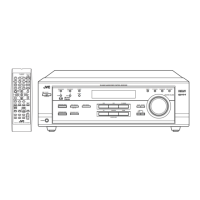
Do you have a question about the JVC RX-5022RSL and is the answer not in the manual?
| Power output | 100 watts per channel into 8Ω (stereo) |
|---|---|
| Total harmonic distortion | 0.09% (20Hz-20kHz, 8 ohms) |
| Dimensions | 420 x 145 x 330 mm (W x H x D) |
| Weight | 9.2kg |
| Input sensitivity | 200mV (line) |
| Speaker load impedance | 8 ohms |
| Video Connections | composite |
| Speaker Impedance | 8 ohms |
General warnings, cautions, and safety guidelines for equipment use.
Detailed safety instructions and usage dos and don'ts.
Identification and labeling of components on the front panel of the receiver.
Identification and labeling of buttons and features on the remote control.
Precautions and location advice before installing the audio/video receiver.
List of included accessories to verify upon unpacking the unit.
Instructions for inserting batteries into the remote control.
Guide on how to connect FM and AM antennas for reception.
Steps and diagrams for connecting front, center, and rear speakers.
Procedures for connecting various audio and video sources to the receiver.
Instructions for safely connecting the unit to a power outlet.
How to power the receiver on and off using the standby button.
How to choose the audio or video input source for playback.
Ability to play video from one source and audio from another.
Instructions for using headphones and disabling speakers.
Methods for controlling the audio output volume.
How to mute and unmute the audio output.
Setting a timer to automatically turn off the receiver.
Adjusting the brightness of the receiver's display.
Registering connected digital components to specific input terminals.
Choosing between analog and digital signal input for a source.
Registering connected speakers and subwoofer status.
Setting the size (large/small/none) for connected speakers.
Configuring the distance of speakers from the listening point.
Adjusting the frequency for reallocation of bass to larger speakers.
Reducing input signal level to prevent distortion from high analog sources.
Balancing the output volume between left and right front speakers.
Modifying bass and treble frequencies for desired sound.
Controlling the volume level of the subwoofer.
Manually searching and tuning FM and AM radio stations.
Storing and recalling favorite radio stations using preset memory.
Choosing between AUTO and MONO modes for FM reception.
Displaying station names, program types, and text via RDS.
Locating programs based on specific Program Type codes.
Temporarily switching to traffic, news, or info broadcasts.
Reproducing realistic sound fields using various surround modes.
Multichannel playback format for 2-channel sources.
Reproducing multichannel sound from Dolby Digital encoded software.
Reproducing multichannel sound from DTS Digital Surround encoded software.
Digital Acoustic Processor modes for creating specific acoustic environments.
Reproducing larger stereo sound fields using all connected speakers.
How speaker configuration affects available surround modes.
Activating and adjusting digital surround sound modes.
Adjusting sound levels and effects for DAP and All Channel Stereo.
Synchronized power control of components with the receiver.
Automating recording setup between a CD player and cassette deck.
Using the remote to control JVC audio devices like CD players and tape decks.
Performing sound adjustments using the remote control buttons.
Using the remote control for tuner operations like station selection.
Basic operations for controlling a VCR using the remote.
Basic operations for controlling a DVD player using the remote.
Basic operations for controlling a TV using the remote.
Technical specifications for the amplifier section, including output power.
Technical specifications for audio inputs, outputs, and frequency response.
Technical specifications for video inputs, outputs, and signal levels.
Technical specifications for the FM tuner section, including sensitivity and response.
Technical specifications for the AM tuner section, including tuning range.
General specifications such as power requirements and dimensions.
